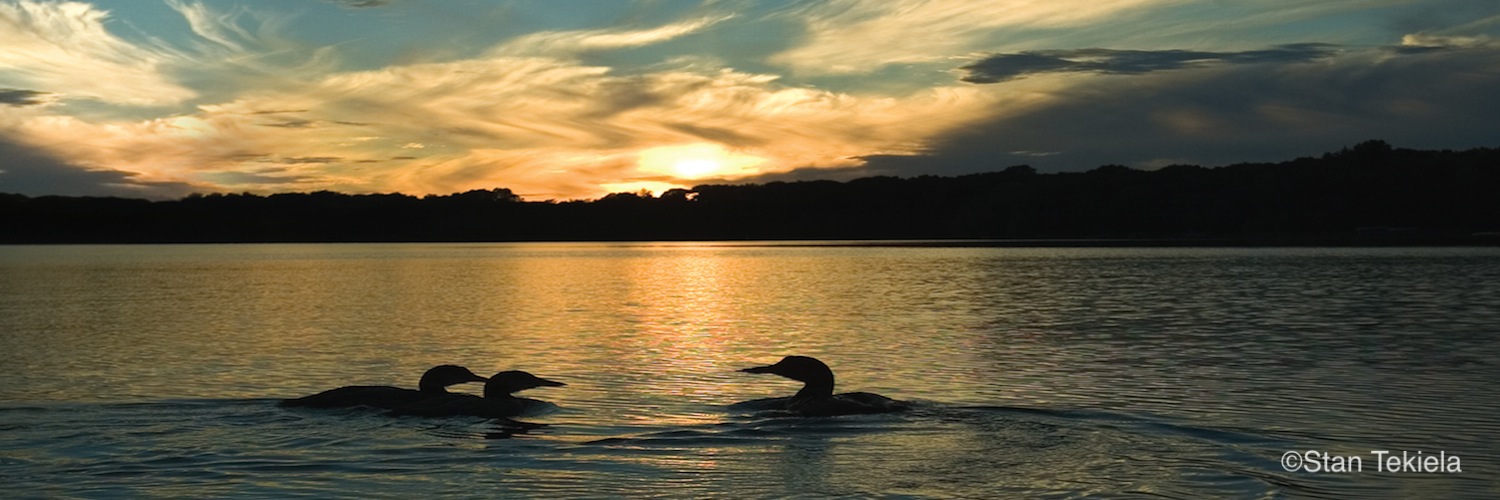
Find out More About the Behaviors of the Common Loon
Dozens of photographers from around the world have come to Stan Tekiela’s home state of Minnesota to photograph and learn the behaviors of the common loon, the iconic bird of the Northwoods. Here is his report!
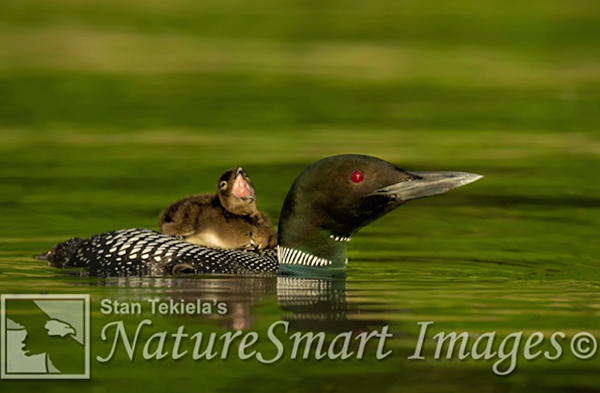
The common loon (Gavia immer) is one of five loon species found in the world. The others are the red-throated loon, black-throated loon, Pacific loon, and yellow-billed loon. In other parts of the world, the common loon is known as the great northern diver.
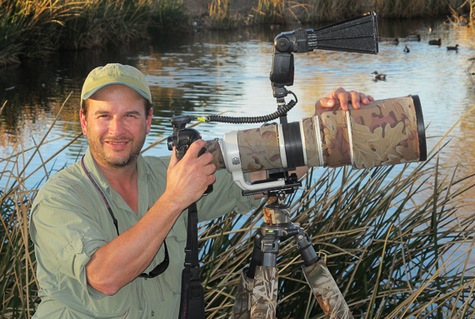
The origin of the common name “loon” isn’t very clear. The word seems strange to my ear. It appears that it comes from the old Scandinavian word lom, meaning “lame” or clumsy or awkward when walking on land. This describes these birds perfectly. Their legs are positioned so far back—and also off to the sides—of their bodies that they are unable to walk upright on land. Their chests remain on the ground as they push themselves along with their legs, much like wheelbarrows.
The association between the name loon and loony or being crazy or insane seems to have come along much later. It might be a chicken-and-egg thing.
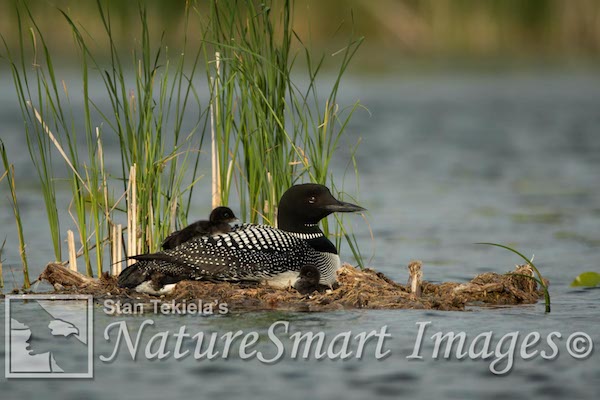
Adult loons are rather large birds measuring over 3 feet from beak to tail. Breeding adults have a smart combination of black and white plumage. The head is completely black, but, when viewed in bright sunlight, it has a green or blue sheen. Not many birds with black feathers are also iridescent.
Often when I’m out on my boat photographing the loons, the adults are catching tiny fish or aquatic insects to feed their chicks. What always amazes me is how fast these large birds can swim underwater. After all, when you think about it, they need to be able to catch tiny fish underwater. Try it yourself sometime and you will have a better appreciation for how remarkable this is. They have to swim faster than a fish and also be able to turn on a dime to continue pursuing their prey.
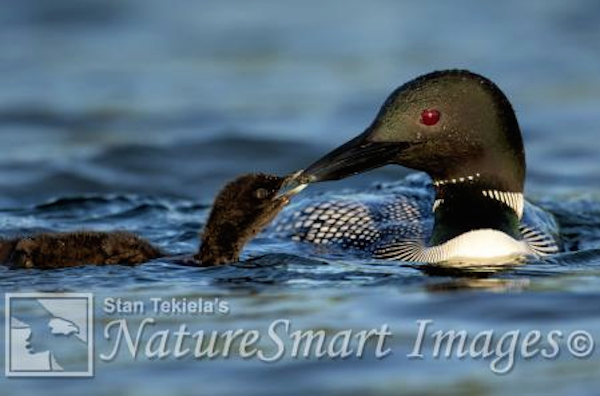
We often see them zipping about underwater at incredibly high speeds. When a loon is chasing fish in shallow water, you can actually see a bow wave on the surface out in front of the bird. Then, all of a sudden, the loon will pop to the water’s surface, a tiny fish held tightly in its large black bill, ready to swim toward its babies.
The parents show great care when feeding their babies. The adults are massive in comparison to the tiny chicks. The parents offer the tiny fish to the young and almost always the young drop the fish. The adults quickly pick up the fish and try again. The young drop it again, and this goes on for many, many tries until finally the chick eats. This kind of feeding goes on for the first week or so of life. Then the babies start to get the hang of it and snatch up the offerings and gobble them down quickly.
Baby loons are well known for riding on the backs of their parents. In fact, this is the behavior that photographers come to capture. The young are only small enough for this activity for about 10 days.
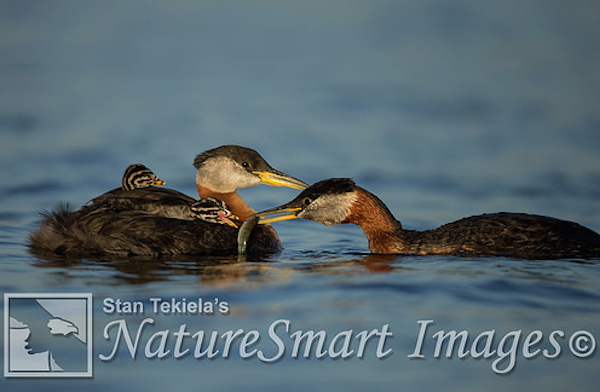
The desire for the young to ride on the adults’ backs is so strong that it doesn’t matter what the parents are doing. The young “must” ride. For example, when the parents are fishing, the babies will climb up on their backs just before they dive underwater. If the young are under the wing, it usually takes a few moments for the babies to pop up to the surface. If the young are riding and the adult wants to stretch its wings, the adult will rise up in the water to shake and the babies will go tumbling into the water.
One time a female climbed up on a tiny cattail island with the babies in hot pursuit. When she got settled on the island, one of the babies had to climb on the back of the resting mother, even though they weren’t in the water. The other youngster snuggled up close to the mother’s chest. These are the sweet and tender moments that I enjoy the most when documenting these amazing birds.
Stan’s book Loons: The Iconic Waterbirds is available now. If you enjoyed Stan’s post, you may consider one of his amazing nature books: Majestic Eagles; The Lives of Wolves, Coyotes, and Foxes; or Backyard Birds: Welcomed Guests at our Gardens and Feeders. Young readers will delight in his award-winning children’s books, such as Whose Butt?, Critter Litter, and his latest, Jump, Little Wood Ducks.
You can follow Stan on Facebook and Twitter, or contact him via his web page. Stan’s nationally syndicated NatureSmart Column appears in more than 25 cities spanning 5 states (Minnesota, Wisconsin, Michigan, Illinois, and Pennsylvania) and is circulated to more than 750,000 readers. Stan’s author page on Amazon features some amazing videos! Check them out, and follow him for updates.
For more stories about wildlife and nature, sign up for our newsletter now!
More posts from Stan:
Indigo Bunting—A Familiar Summer Visitor
The Nesting Behaviors of Sandhill Cranes
Big Birds, Baby Birds, Birds Everywhere
Stan Tekiela observes Marsh Wrens
The Magical, Mystical World of Sandhill Cranes



Sway Scheck
Hi there! I would like to know the life cycle of a loon please! Thanks!
Liliane Opsomer
Good morning,
The title of the blog post is not correct and I will change it today. There is not enough about the Life Cycle in it, but it is rather about some behaviors of the Common Loon. Loons can live up to 30 years. If you are interested in loons you may enjoy Loons: The Iconic Waterbird by Stan Tekiela https://shop.adventurewithkeen.com/product/loons/